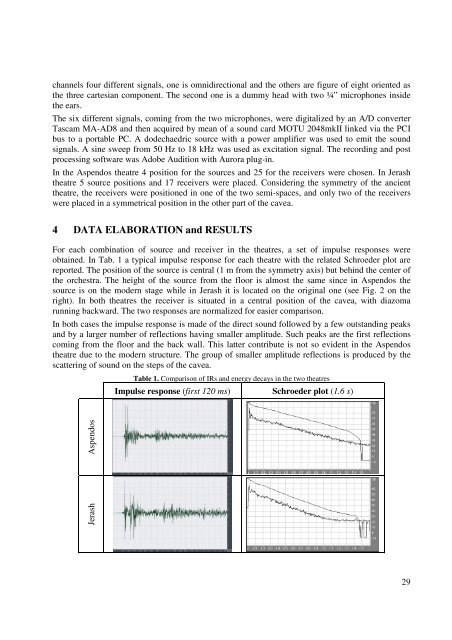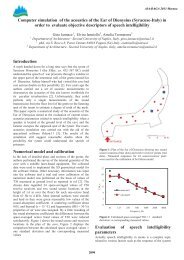ERATO Proceedings Istanbul 2006.pdf - Odeon
ERATO Proceedings Istanbul 2006.pdf - Odeon
ERATO Proceedings Istanbul 2006.pdf - Odeon
You also want an ePaper? Increase the reach of your titles
YUMPU automatically turns print PDFs into web optimized ePapers that Google loves.
channels four different signals, one is omnidirectional and the others are figure of eight oriented as<br />
the three cartesian component. The second one is a dummy head with two ¼” microphones inside<br />
the ears.<br />
The six different signals, coming from the two microphones, were digitalized by an A/D converter<br />
Tascam MA-AD8 and then acquired by mean of a sound card MOTU 2048mkII linked via the PCI<br />
bus to a portable PC. A dodechaedric source with a power amplifier was used to emit the sound<br />
signals. A sine sweep from 50 Hz to 18 kHz was used as excitation signal. The recording and post<br />
processing software was Adobe Audition with Aurora plug-in.<br />
In the Aspendos theatre 4 position for the sources and 25 for the receivers were chosen. In Jerash<br />
theatre 5 source positions and 17 receivers were placed. Considering the symmetry of the ancient<br />
theatre, the receivers were positioned in one of the two semi-spaces, and only two of the receivers<br />
were placed in a symmetrical position in the other part of the cavea.<br />
4 DATA ELABORATION and RESULTS<br />
For each combination of source and receiver in the theatres, a set of impulse responses were<br />
obtained. In Tab. 1 a typical impulse response for each theatre with the related Schroeder plot are<br />
reported. The position of the source is central (1 m from the symmetry axis) but behind the center of<br />
the orchestra. The height of the source from the floor is almost the same since in Aspendos the<br />
source is on the modern stage while in Jerash it is located on the original one (see Fig. 2 on the<br />
right). In both theatres the receiver is situated in a central position of the cavea, with diazoma<br />
running backward. The two responses are normalized for easier comparison.<br />
In both cases the impulse response is made of the direct sound followed by a few outstanding peaks<br />
and by a larger number of reflections having smaller amplitude. Such peaks are the first reflections<br />
coming from the floor and the back wall. This latter contribute is not so evident in the Aspendos<br />
theatre due to the modern structure. The group of smaller amplitude reflections is produced by the<br />
scattering of sound on the steps of the cavea.<br />
Table 1. Comparison of IRs and energy decays in the two theatres<br />
Impulse response (first 120 ms) Schroeder plot (1.6 s)<br />
Jerash<br />
Aspendos<br />
29
















